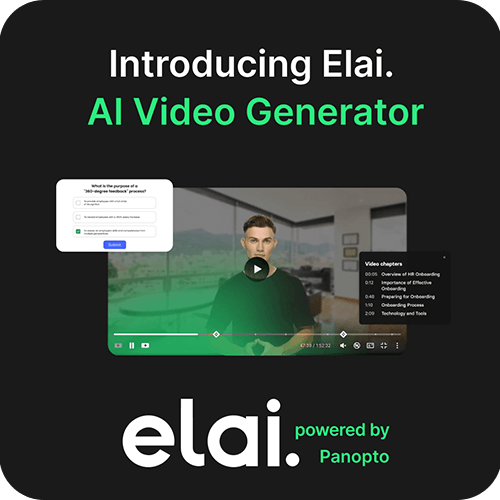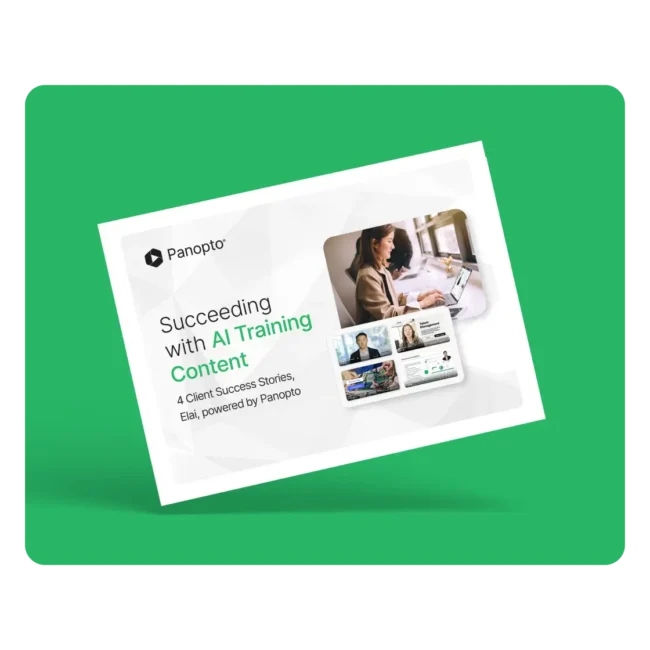- Hochschulbildung
Verschiedene Arten von KI im Lernen verstehen

Künstliche Intelligenz (KI) verändert die Art und Weise, wie wir Geschäfte machen – und wie wir lernen. Von Hochschulen bis hin zur Schulung von Mitarbeitern bietet die Leistungsfähigkeit der KI Verbesserungsmöglichkeiten in den Bereichen Abläufe, Lernmodelle und mehr.
Was ist KI?
KI ist eine Art von Technologie, die es Computern und Maschinen ermöglicht, menschliches Lernen, Problemlösung, Entscheidungsfindung und Kreativität zu imitieren. Es bietet branchenübergreifend mehrere Vorteile, wie z. B. die Automatisierung sich wiederholender Aufgaben, die Gewinnung von mehr und schnelleren Erkenntnissen aus Daten, die Verbesserung der Entscheidungsfindung und die Eliminierung menschlicher Fehler.
Here’s a look at how three types of AI power successful outcomes for the workforce and higher education.
Generative KI im Lernen
Wie wird generative KI beim Lernen eingesetzt?
Generative KI ist eine Technologie der künstlichen Intelligenz, die neue Inhalte wie Audio, Code, Bilder, Text und Video erstellen kann. Es kann den Lernenden schnell sofortigen Zugriff auf große Mengen an Informationen bieten, Lernende mit unterschiedlichem Sprachhintergrund oder unterschiedlichen Anforderungen an die Barrierefreiheit unterstützen und die Erkundung und Kreativität beschleunigen.
Drei Vorteile von generativer KI für das Lernen.
Personalisierung
Generative KI-Algorithmen können maßgeschneiderte Bildungsinhalte wie bestimmte Videos oder Artikel generieren, die auf den individuellen Vorlieben oder Anforderungen eines Lernenden basieren.
Automatisierung der Bewertung
In der Hochschulbildung zum Beispiel nutzen einige Dozierende generative KI-Tools, um den Studierenden sofortiges Feedback zu ihren Studienleistungen zu geben.
Adaptives Lernen
Computeralgorithmen und KI können maßgeschneiderte Ressourcen und Lernaktivitäten generieren, die auf die individuellen Bedürfnisse der Lernenden zugeschnitten sind. Wenn ein neuer Mitarbeiter beispielsweise mit einem Softwareprogramm, das er verwenden wird, nicht vertraut ist, empfiehlt ein adaptives Training möglicherweise Lernmodule, in denen die Verwendung des Softwareprogramms erläutert wird, bevor tiefer in die Themen eingetaucht wird.
Bedenken hinsichtlich generativer KI beim Lernen.
Trotz der Vorteile ist generative KI nicht ohne Herausforderungen. Die Werkzeuge generieren neue Inhalte auf der Grundlage der Datensätze, mit denen sie trainiert wurden, und wenn diese Datensätze Verzerrungen enthalten, können die neuen Inhalte auch verzerrt sein. Generative KI kann auch ungenaue Informationen verbreiten, wie z. B. das Zitieren gefälschter wissenschaftlicher Studien als Beweis für einen Standpunkt. Das ist wohl der Grund, warum Studierende generativen KI-Content-Tools weitgehend skeptisch gegenüberstehen. In einer aktuellen Studie aus demPanopto vertrauen weniger als die Hälfte der Studierenden auf generative KI, um passgenaue Inhalte zu generieren. Eine Studie von Forbes stellte außerdem fest, dass 41 % der Studierenden angaben, KI-generierte Inhalte immer zu bearbeiten, während 3 % angaben, dies nie zu tun.
Prädiktive KI im Lernen
Wie wird prädiktive KI beim Lernen eingesetzt?
Prädiktive KI nutzt maschinelles Lernen, um Muster in vergangenen Ereignissen zu erkennen und Vorhersagen über zukünftige Ereignisse zu treffen. Predictive AI kann die Daten der Lernenden in der Lernumgebung schnell analysieren, um Einblicke in ihre Lernmuster und ihren Lernfortschritt zu erhalten und vorherzusagen, welche Themen sie als nächstes lernen müssen.
Drei Vorteile von Predictive AI für das Lernen.
Improved outcomes
Predictive analytics can help identify learners who need extra help and provide targeted support, improving their learning outcomes in the long term. For example, all bank employees may need training about a new government regulation affecting financial institutions. Still, one who struggles to answer specific questions might be prompted to take a review course on existing banking regulations to provide them with the necessary background. A college student who keeps rewatching a particular math lecture or asking automated questions about a particular math concept might be prompted to watch or review a lesson about a foundational concept that would help them to understand the new concept better.
Verbesserte Planung
Ausbilder und Trainer können mit Predictive Analytik Bereiche eines Trainingsprogramms identifizieren, die gut funktionieren und welche Bereiche verbessert werden müssen. Mit diesen Erkenntnissen können sie Schulungsprogramme und Unterrichtsstrategien verfeinern, um die Bedürfnisse der Lernenden besser zu erfüllen.
Verbesserte Ressourcenzuweisung
Predictive AI kann vorhersagen, welche Lernenden und Kohorten mehr Unterstützung benötigen, und hilft Organisationen oder Hochschuleinrichtungen, Ressourcen am vorteilhaftesten zu planen und zu verteilen.
Bedenken hinsichtlich prädiktiver KI beim Lernen.
Da Predictive Analytik von Unternehmen verlangt, viele Informationen über die Lernenden zu sammeln und zu speichern, kann es Bedenken hinsichtlich des Datenschutzes und der Datensicherheit geben. Hochschulbildungseinrichtungen und Organisationen, die prädiktive KI in ihren Lernprogrammen einsetzen, müssen die Datenschutzgesetze befolgen und robuste Cybersicherheitsmaßnahmen einsetzen, um die von ihnen verwendeten Daten zu schützen. Sie sollten sich auch mit den Lernenden über die Arten der gesammelten Daten und die Maßnahmen zum Schutz ihrer Privatsphäre austauschen.
Eine Möglichkeit, Datenschutzbedenken auszuräumen, besteht darin, mit Anbietern zusammenzuarbeiten, die den Datenschutz ernst nehmen. Die kundenorientierte KI-Datenschutzrichtlinie von Panopto ermöglicht es Unternehmen beispielsweise, sich auf die ethische Nutzung von Daten für die KI-Modellierung und Technologieentwicklung zu einigen.
Deskriptive KI im Lernen
Wie wird deskriptive KI beim Lernen eingesetzt?
Deskriptive KI-Tools werden darauf trainiert, Metadaten aus unstrukturierten Daten wie aufgezeichneten Vorlesungen oder Geschäftsdokumenten zu generieren. Sie können Datenmuster und -beziehungen aufdecken, sie in verschiedene Komponenten klassifizieren und vergangene Leistungen, Trends oder andere relevante Faktoren zusammenfassen.
Drei Vorteile von deskriptiver KI für das Lernen.
Datengestützte Erkenntnisse. Deskriptive KI-Tools können Daten über die Interaktion eines Lernenden mit Bildungsmaterialien, die Abschlusszeit, die Testergebnisse und die Leistung sammeln und analysieren. Dozenten und Schulungsleiter können diese Daten nutzen, um den Erfolg eines Lernprogramms zu messen und Entscheidungen über zukünftige Programme zu treffen.
Notizen machen
Lernende können von deskriptiven KI-Tools profitieren, die Videos oder Vorlesungen schnell zusammenfassen und dabei helfen können, sich Notizen zu wichtigen Punkten zu machen. DiePanopto Access AI-Produktsuite von bietet beispielsweise automatisierte Transkripte, Zusammenfassungen der wichtigsten Punkte und Beschreibungen von Lernvideos mit einem Mausklick.
Virtuelle Nachhilfe
Virtuelle Tutoren, die auf deskriptiver KI basieren, können Echtzeit-Feedback und Unterstützung in der Hochschulbildung bieten und den traditionellen Unterricht im Klassenzimmer ergänzen.
Bedenken hinsichtlich deskriptiver KI beim Lernen
Wie bei anderen Formen der KI bleiben Datenschutz und Sicherheit auch für Hochschulbildungseinrichtungen und Arbeitsplätze, die deskriptive KI einsetzen, ein Problem. Es ist wichtig, strenge Datenschutzrichtlinien und -überprüfungen zu entwickeln, um die Datensicherheit zu gewährleisten.
Erfahren Sie mehr über Panopto AI im Lernen
Panopto's Die KI-gestützte Video-Learning-Plattform skaliert barrierefreies Lernen außerhalb des Campus für 1650+ Bildungseinrichtungen weltweit. Mit Transkriptionen und Untertiteln für 20+ Sprachen, einer KI-gestützten Stichwortsuche, die den Lernenden hilft, Inhalte schnell zu finden, und automatischen Workflows für die Übersetzung von Videoinhalten skaliert Panopto das Videolernen mit einer einfach zu bedienenden Plattform, die speziell für den Bildungsbereich entwickelt wurde.
Neueste Blogeinträge
-

- Vertrieb
How to Make Sales Presentation Videos With AI
A sales presentation can make or break a deal—yet too many sales teams still rely on outdated slides and monotonous pitches. Video content accounts for over 82% of consumer internet traffic. We live in a digital-first world where video is the key to capturing attention and driving engagement. But creating a polished, persuasive sales video…
How to Make Sales Presentation Videos With AI
-

- Aktives Lernen
Why Every Business Needs an Upskilling Strategy (And How to Build One)
A strong upskilling strategy is no longer optional. It’s essential for keeping pace with rapid technological advancements and shifting market demands. As AI and automation reshape industries, companies must ensure their employees continuously develop new skills to stay competitive. But upskilling alone isn’t enough. Reskilling is equally critical for preparing workers to transition into entirely…
Why Every Business Needs an Upskilling Strategy (And How to Build One)
-

- Schulung
How to Turn Policy Updates into Just-in-Time Training Videos
In today’s fast-paced workplaces—whether on the manufacturing floor or the trading floor—keeping employees updated on policy changes is critical. But let’s face it: expecting your workforce to sift through long policy documents is unrealistic, especially when time is tight. That’s where the power of just-in-time training videos comes in. This article explores how you can…
How to Turn Policy Updates into Just-in-Time Training Videos



